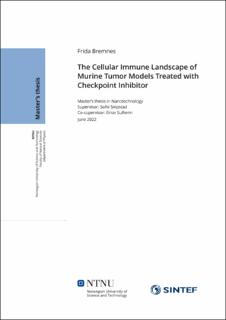| dc.contributor.advisor | Snipstad, Sofie | |
| dc.contributor.advisor | Sulheim, Einar | |
| dc.contributor.author | Bremnes, Frida | |
| dc.date.accessioned | 2022-10-07T17:34:22Z | |
| dc.date.available | 2022-10-07T17:34:22Z | |
| dc.date.issued | 2022 | |
| dc.identifier | no.ntnu:inspera:115467227:37287298 | |
| dc.identifier.uri | https://hdl.handle.net/11250/3024796 | |
| dc.description.abstract | I denne oppgaven undersøkes effekten av en anti-PD1 sjekkpunktshemmer og implantasjonsstrategi på det cellulære immunlandskapet til murine tumormodeller. Behandling med sjekkpunktshemmere har vist imponerende effekter i pasienter, men de gode resultatene har dessverre som mange typer immunterapi vært begrenset til enkelte pasientgrupper. På grunn av dette pågår det mye forskning som forsøker å forstå den heterogene responsen observert i pasienter og identifisere biomarkører som kan forutsi hvilke pasientgrupper som kan ha nytte av immunterapi. Et viktig verktøy for å kunne evaluere effekten av immunterapi er immunkompetente murine modeller. Når man skal bruke murine modeller til å belyse de underliggende årsakene til resistens mot immuntapi er det essensielt å ha et grunnleggende rammeverk for å kunne velge den modellen med høyest klinisk relevans for de spesifikke mekanismene man vil undersøke.
Fire immunokompetente murine modeller behandlet med en anti-PD1 sjekkpunkts hemmer har blitt karakterisert i dette projektet, med mål om å bygge kompetanse innen bruk av murine modeller til å evaluere immunoterapi. Modellene tilsvarer metastatisk lungekreft (CMT167), trippel negativ brystkreft (4T1), bukspyttkjertelkreft (KPCY) og tykktarmskreft (MC38). To ulike teknikker er brukt for implantering, injisering av cellene under huden på bakbenet (subkutan) og implantering av cellene i det respektive organet cellelinjen kommer fra (ortotopisk). Begge metodene ble brukt for alle tumormodellene bortsett fra MC38 som bare ble implantert subkutant. Celler fra det medfødte og adaptive immunforsvaret har blitt kvantifisert ved flowcytometrianalyse av enkeltcellesuspensjoner, og konfokalmikroskopi har blitt brukt til å kvantifisere tettheten og fordelingen av T celler i frosne snitt av de samme tumorene (hele organet ble brukt til analyse i de ortotopiske CMT167 og KPCY modellene).
Resultatene av analysen viste betydelige forskjeller mellom modellene, både i det cellulære immunlandskapet og hvordan de responderte på anti-PD1 behandling. Den mest responsive modellen var tykktarmskreftmodellen MC38, imens den minst responsive var brystkreftmodellen 4T1. God respons på behandling ble knyttet til økt mengde CD8+ T celler, men en høy infiltrasjon av CD8+ T celler før behandling kunne ikke predikere en god respons. På bakgrunn av dette er det mistanke om en balanse mellom antitumoreffektene som primært utøves av cytotoksiske CD8+ T-celler og modellspesifikke immunsuppressive mekanismer. Potensielle mekanismer inkluderer immunsuppressive myeloide celler, regulatoriske adaptive immunceller og fysiske barrierer som forhøyet mengde bindevev. Effekten av implanteringsteknikk var modellspesifikk, og mest fremtredende for CMT167 og KPCY modellene. Imidlertid var disse resultatene uklare da hele organet ble brukt til analyse av de ortotopiske modellene, hvilket understreker viktigheten av å bruke bildeanalyse som et supplement for å validere flowcytometridata.
Denne oppgaven kan brukes som et grunnlag for videre utforskning av spesifikke mekanismer kan forårsake resistens mot sjekkpunktshemmere og andre immunterapier. Det anbefales at videre arbeid utvider repertoaret av celler til å inkludere flere anti-tumor subpopulasjoner av immunsupressive of regulatoriske celler for å kunne belyse balansen mellom antitumor- og protumormekanismer. | |
| dc.description.abstract | This thesis investigates the effect of anti-PD1 checkpoint inhibitors and implantation strategies on the cellular immune landscape of murine tumor models. The astonishing effects of checkpoint inhibitors and other emerging immunotherapies have been compelling, but the efficacy has unfortunately been limited to subsets of patients. Current efforts strive to elucidate the underlying mechanisms of the heterogeneous response and identify potential biomarkers for patient stratification. Immunocompetent murine models are essential pre-clinical tools for the evaluation of immunotherapies. However, a fundamental framework is needed to choose clinically relevant model systems to explore the specific mechanisms of therapy resistance in patients.
Four immunocompetent murine models treated with anti-PD1 checkpoint inhibitor have been characterized with the aim of building competence within murine model systems for the evaluation of immunotherapies. The models resemble metastatic lung cancer (CMT167), triple-negative breast cancer (4T1), pancreatic cancer (KPCY), and colon cancer (MC38). Two different implantation strategies have been used, injection of cells under the skin of the hind leg (subcutaneous) and implantation into the organ of origin (orthotopic). Both implantation strategies were utilized for all tumor models except for MC38, which only was grown subcutaneously. A range of innate and adaptive immune cells have been quantified by flow cytometry analysis of single-cell suspensions prepared from the tumors. Confocal laser scanning microscopy has been used with immunohistochemistry to quantify the density and distribution of T cells in frozen sections of the same tumors (the whole organ was analysed for the orthotopic lung and pancreas models).
Analysis revealed a model-dependent cellular immune landscape and variable responsiveness towards anti-PD1, ranging from the most responsive MC38 colon cancer model to the least responsive 4T1 breast cancer model. Robust responses were connected to increased infiltration of CD8+ T cells. However, a high infiltration of CD8+ T cells in untreated tumors was not directly predictive of a favorable response. Thus, it is suspected that there is a balance between the anti-tumor effects exerted primarily by cytotoxic CD8+ T cells and model-specific immunosuppressive mechanisms. Potential mechanisms identified include immunosuppressive myeloid cells, regulatory adaptive immune cells, and physical barriers such as excessive connective tissue. The effect of the implantation strategy was model-dependent, with the most prominent differences observed in the CMT167 and KPCY models. However, these results were partially obscured due to whole-organ analysis including healthy cells, stressing the importance of using image analysis to validate flow cytometry data.
This thesis can provide a foundation for further investigations of specific mechanisms behind therapy resistance towards checkpoint inhibitors and other immunotherapies. Further work is recommended to include additional subsets of immunosuppressive and regulatory cells to elucidate the balance between anti-tumor and pro-tumor mechanisms. | |
| dc.language | eng | |
| dc.publisher | NTNU | |
| dc.title | The Cellular Immune Landscape of Murine Tumor Models Treated with Checkpoint Inhibitor | |
| dc.type | Master thesis | |
